Scorching summers, monsoon bursts, and peach-gold sunsets give Arizona backyards their own personality—and their own design rules. The 20 ideas below harness native plants, precision watering, cooling shade, and night-loving amenities that local landscapers spotlighted as 2025’s most-requested upgrades, from xeriscapes that cut thousands of gallons of irrigation to solar LEDs that let you linger long after dark. Whether you garden in Tucson’s sandy foothills or Phoenix’s gravelly suburbs, you’ll find low-maintenance, high-impact inspiration tuned to the Southwest’s extremes. Ready to squeeze every drop of water and every ray of sun out of your slice of desert? Explore the possibilities ahead.
1. Arizona Backyard Xeriscape Oasis
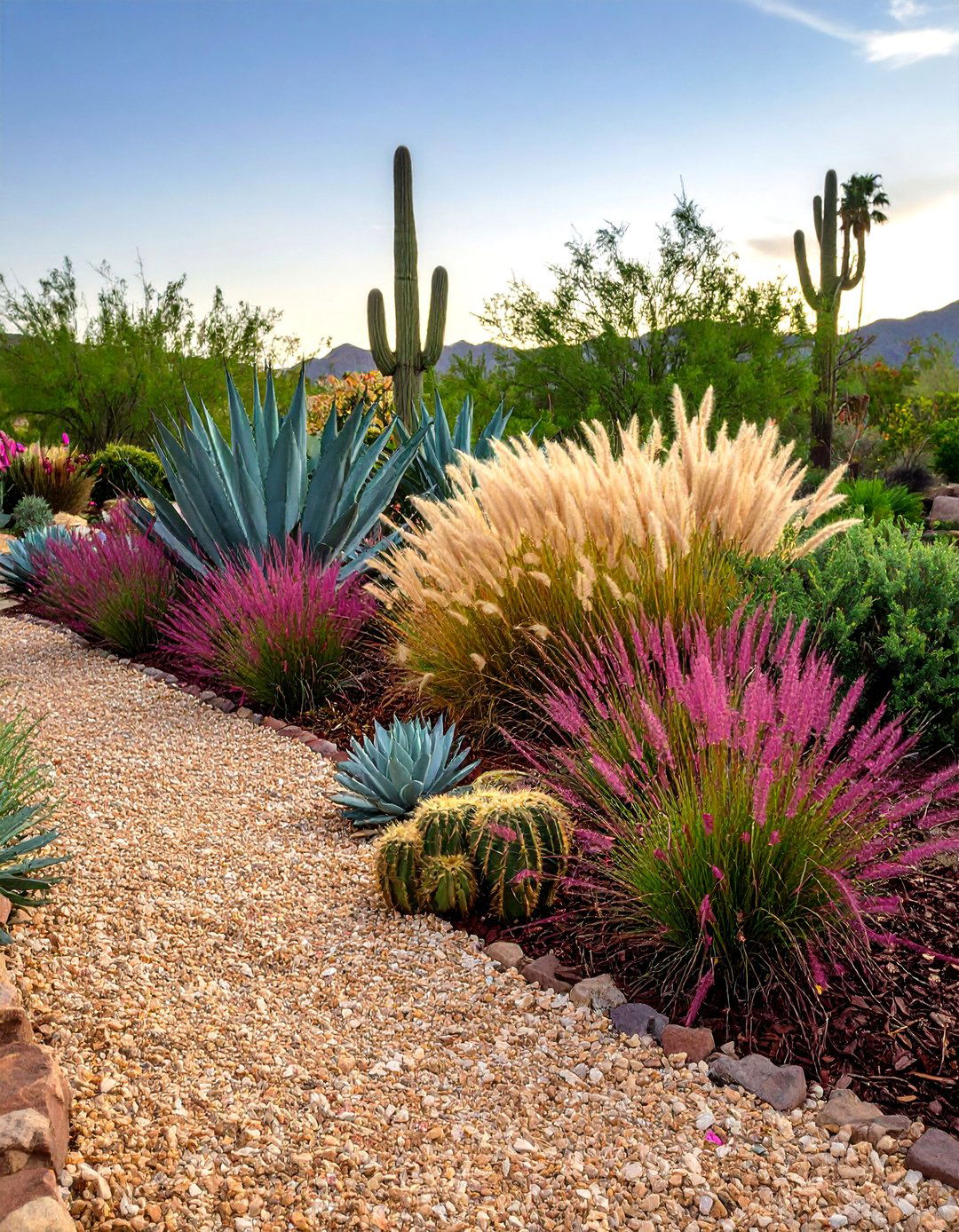
A gentle carpet of crushed rock dotted with silver-blue agave and blooming chuparosa turns an ordinary Arizona backyard into a water-wise xeriscape oasis, echoing 2025’s eco-feature trend. Layer hardy natives such as Baja fairy duster, turpentine bush, and pink muhly grass for four-season color that thrives on once-a-month deep soaks. Swap thirsty turf for decomposed-granite walkways or ½-inch screened gravel to create cooler footing, eliminate mowing, and need only occasional raking. Finally, blanket exposed soil with two inches of organic mulch to slash surface evaporation by up to 70 percent during triple-digit afternoons.
2. Arizona Backyard Shade-Sail & Pergola Duo
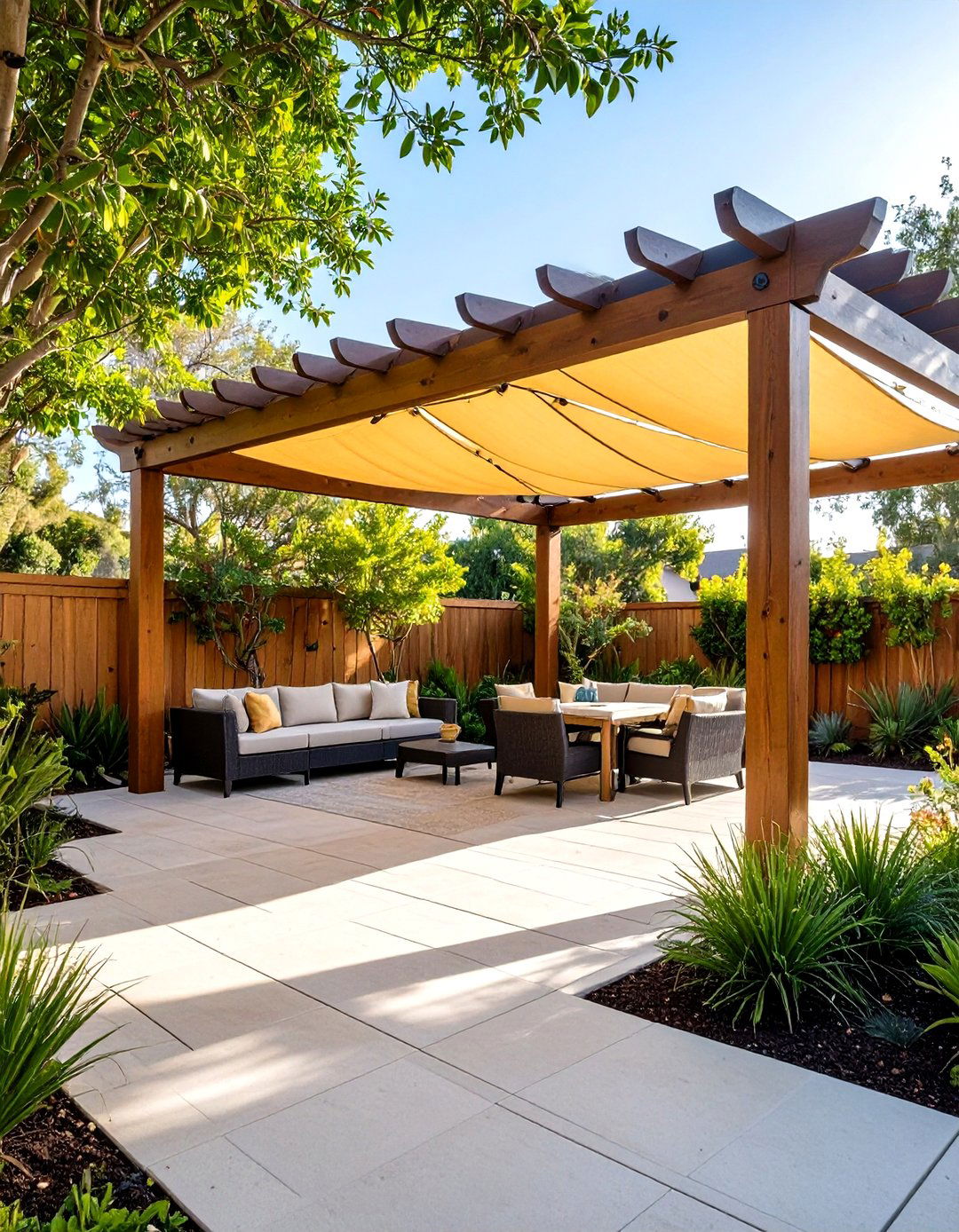
Unlike a lone canvas sail, pairing an adjustable shade sail with a custom pergola delivers layered, all-day protection from 110 °F sun while leaving the night sky wide open. Choose freestanding ramadas or attached pergolas that mirror your roofline, then tension triangular sails between beams to block brutal western glare. Desert architects orient seating and grills beneath these structures, combining mist lines and heat-reflective pavers to lower ambient temperatures roughly 15 °F. Plant fast-growing desert-museum palo verde on the west edge so its filtered shade protects fabric and frames golden spring blooms.
3. Arizona Backyard Low-Water Lawn Alternatives
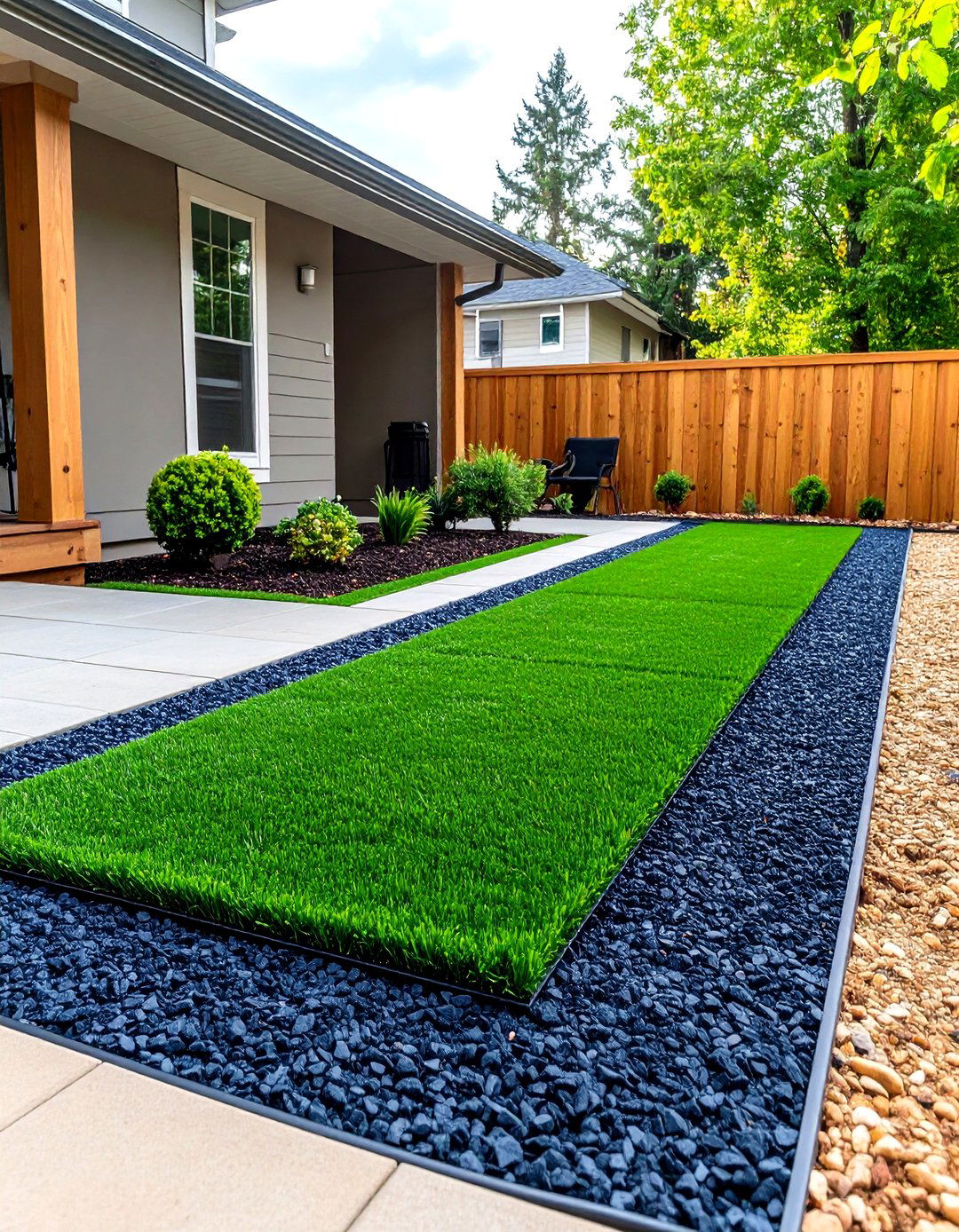
A postage-stamp patch of premium artificial turf can actually be greener in Arizona than fescue because polyethylene blades stay lush with an occasional rinse and zero irrigation. Homeowners often frame turf islands with pavers or gravel to give kids and pets a cool play zone without violating xeriscaping goals. If you crave organics, try a desert wildflower meadow—trending in 2025 designs—to provide seasonal color, then gracefully go dormant after monsoon rains. Keep any “green” area under 400 square feet so a hose-end sprinkler can handle watering without spiking your bill.
4. Arizona Backyard Smart Drip Irrigation Grid
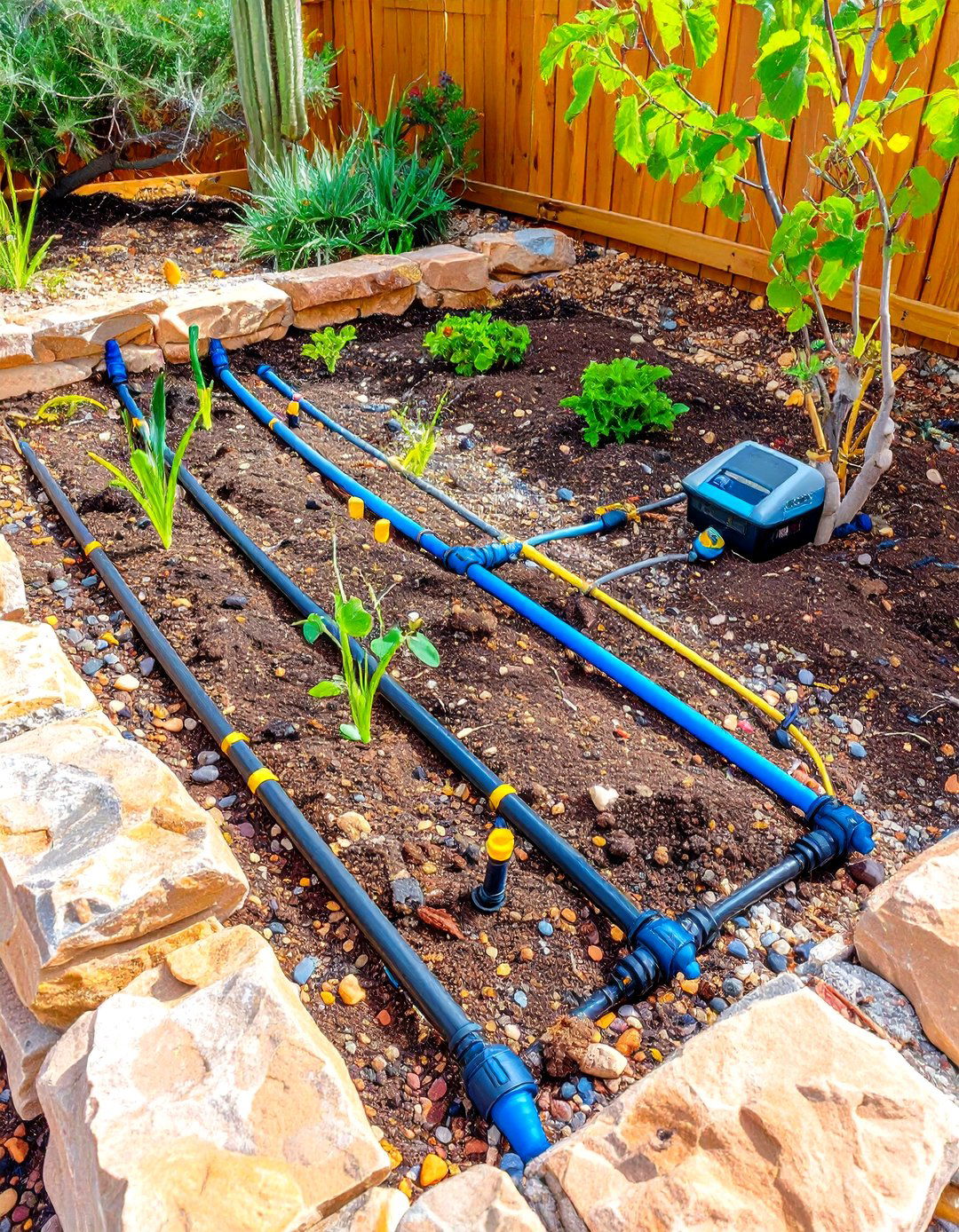
Deliver 0.5–4 gallons per hour straight to the root zone with a drip system buried under two inches of gravel. Pair emitters with a Wi-Fi controller that automatically cuts runtime by half in winter and restores it by May, maximizing savings. Extension experts warn against micro-tubing runs longer than five feet—cluster thirstier plants together and stub one lateral into the group. Cover lines with fresh mulch so early-morning cycles lose minimal moisture, a tactic that trims use another 30 percent in extreme heat.
5. Arizona Backyard Compact Plunge Pool Retreat
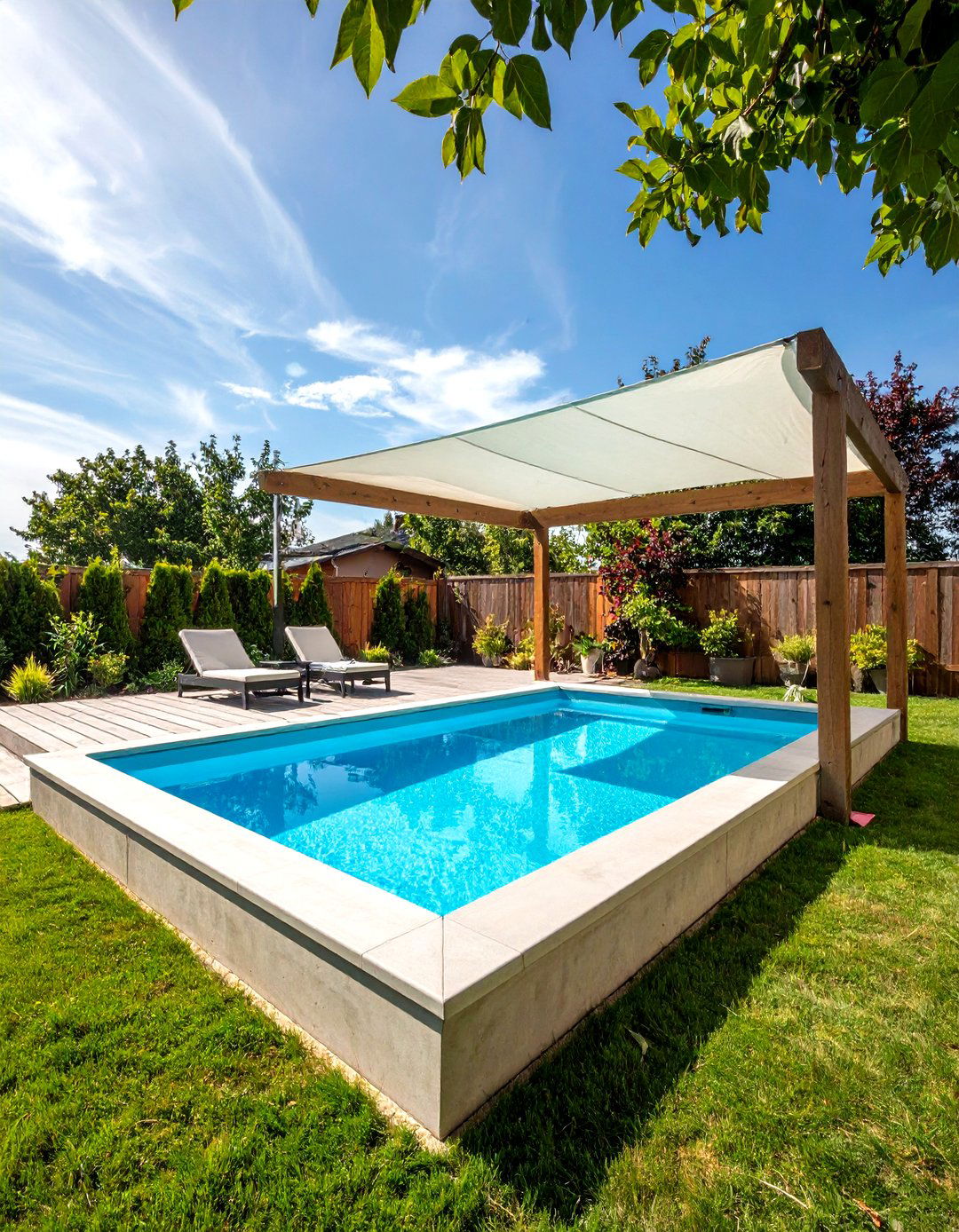
A prefabricated 8 × 12-foot plunge pool slips into tight lots for $25,000–$55,000, cooling bodies without hogging square footage. Concrete shells run $40,000–$90,000 but shrug off desert ground heave better than vinyl and last decades. Builders add Baja shelves and umbrella sleeves so the small pool doubles as a splash pad—no extra water needed. Finish with a reflective sail overhead to tame midday water temps and a solar cover that curbs nightly evaporation.
6. Arizona Backyard Heat-Savvy Raised Bed Garden
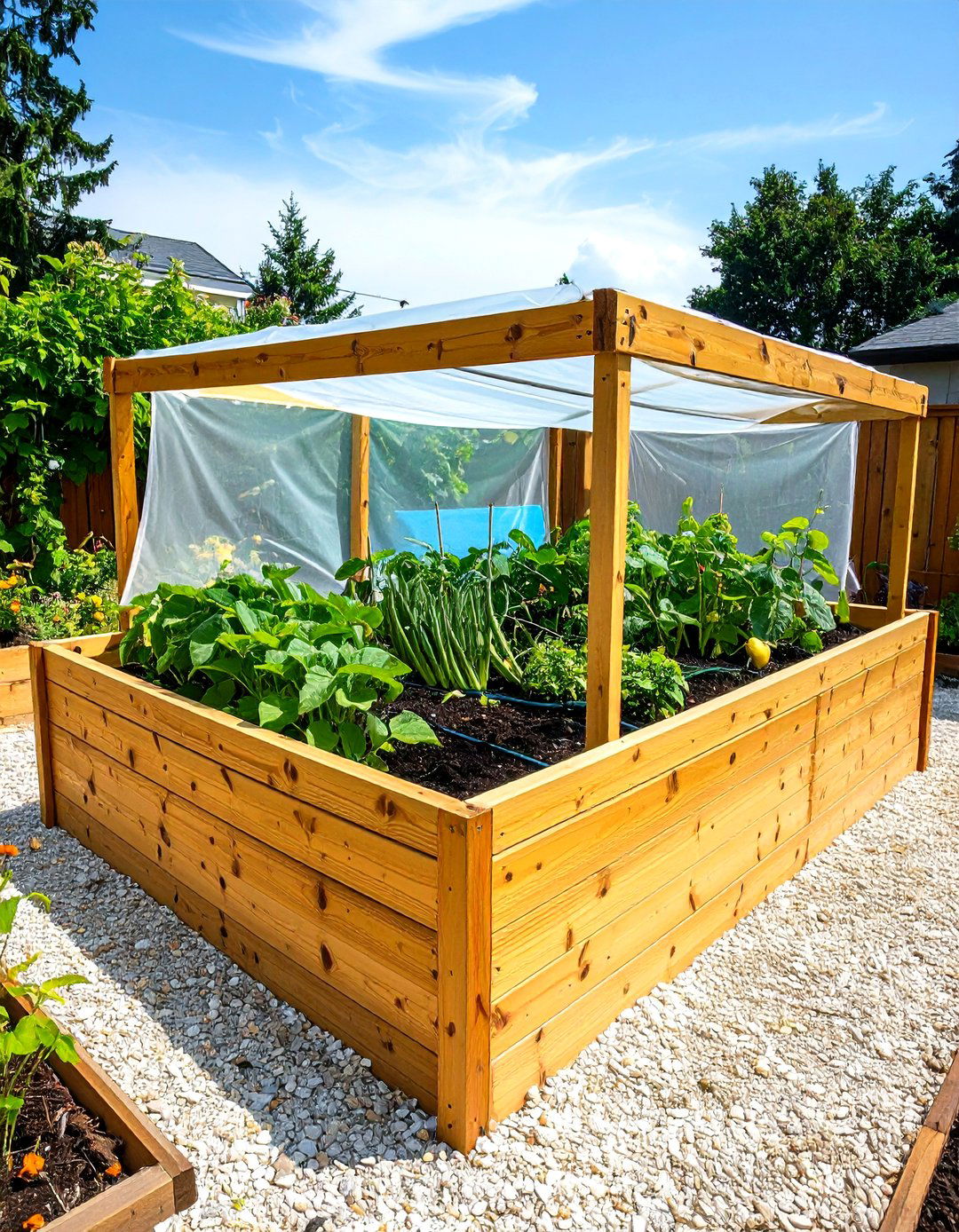
What keeps lettuce crisp at 110 °F? A waist-high cedar box shaded by 40 percent cloth, which drops ambient temperatures around greens by roughly 15 °F. Lay inexpensive drip tape inside each bed to hydrate soil directly and slash sunscald. Swap cool-weather crops for Armenian cucumbers, tepary beans, and heat-loving basil—favorites of low-desert gardeners that keep producing through July swelter. Surround beds with light-colored gravel to reflect light upward, giving vining vegetables an extra boost without baking the soil.
7. Arizona Backyard Pollinator Habitat Patch
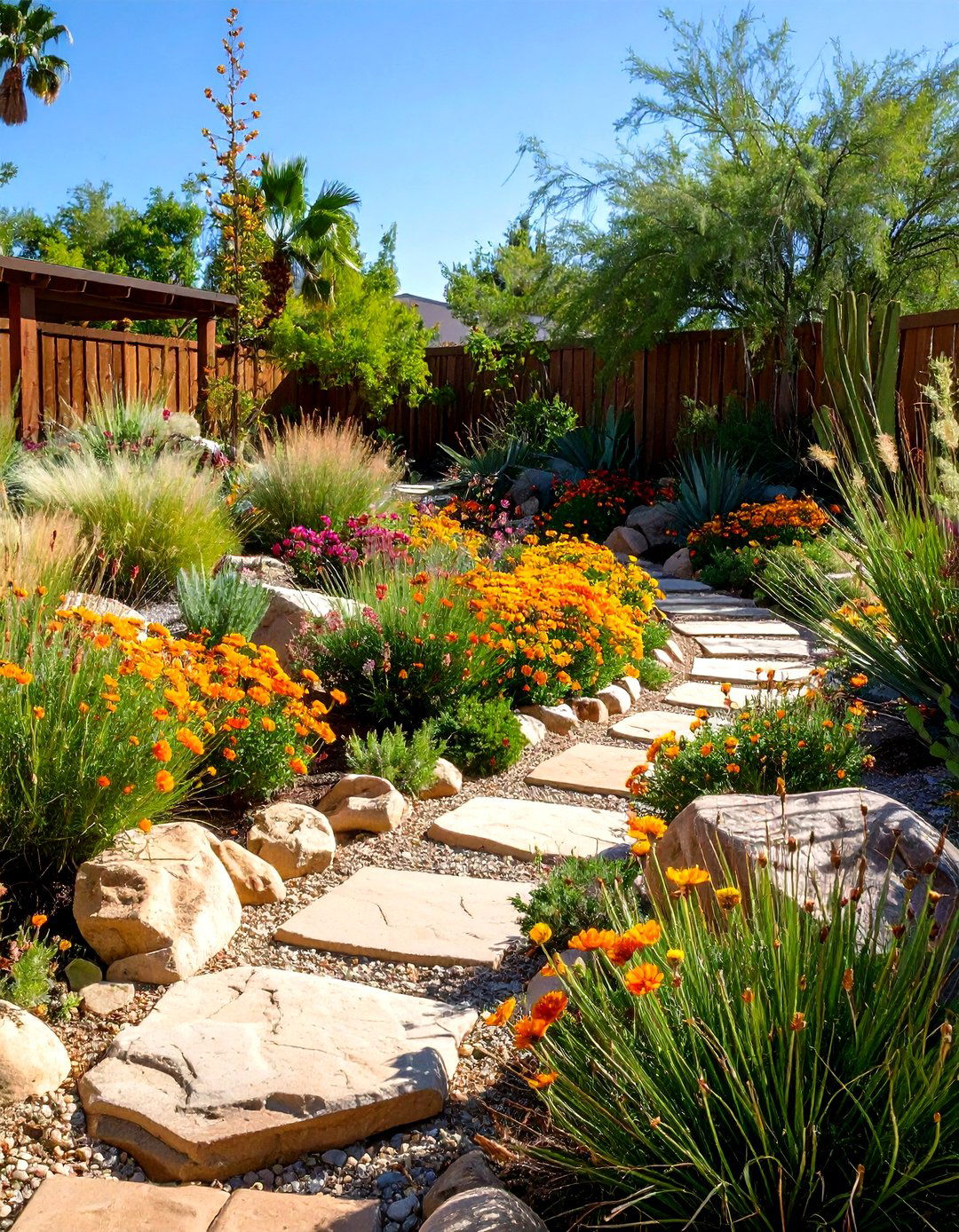
Certainly, a ribbon of Baja fairy duster and chuparosa shrubs pulls in hummingbirds and butterflies within weeks, all while sipping minimal water. Tuck buttonbush or desert marigold between them to add nectar through late summer when resources run low. Leave spent blooms standing until winter to offer seed for goldfinches and shelter for native bees. Finish the mini-meadow with flat rocks that heat up at dawn, giving pollinators a warm landing pad before they forage.
8. Arizona Backyard Fire Pit Gathering Zone

Phoenix allows recreational fire pits year-round except during “no-burn” alerts, so design yours with that rule in mind. Choose a CSA-approved gas insert if you want instant ignition on windless weeknights; wood models are fine but must stay 15 feet from structures and have a hose or extinguisher nearby. Ring the pit with a semicircle of decomposed-granite seating topped by heat-resistant pavers so friends can toast s’mores without scorching their shoes. Add a lockable steel mesh lid to keep drifting embers off your xeriscape plants.
9. Arizona Backyard Desert Night Lighting
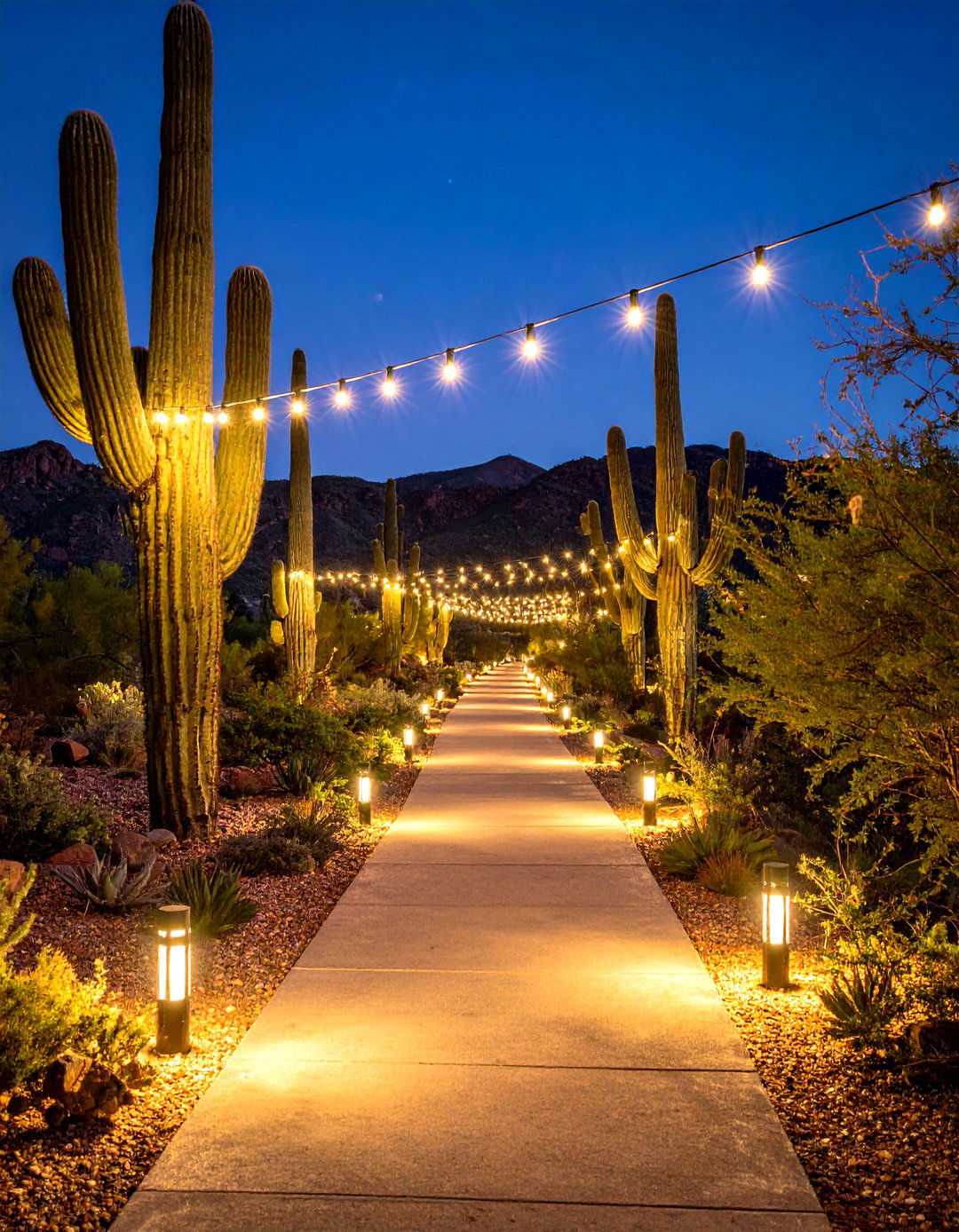
Solar-powered LED fixtures thrive in Arizona, charging under six hours of desert sun and glowing for eight, all on low-voltage wiring that’s safer around kids and pets. Designers layer uplights on saguaros, path lights along decomposed-granite trails, and twinkling string lights between palo verdes to create “night-scaping” that encourages outdoor living after sundown. Even budget-friendly café strands add cozy ambience and invite cooler evening gatherings without adding to the electric bill. Position fixtures to respect Dark-Sky ordinances, keeping beams under the fence line so neighbors still see the Milky Way.
10. Arizona Backyard Rainwater Harvesting System
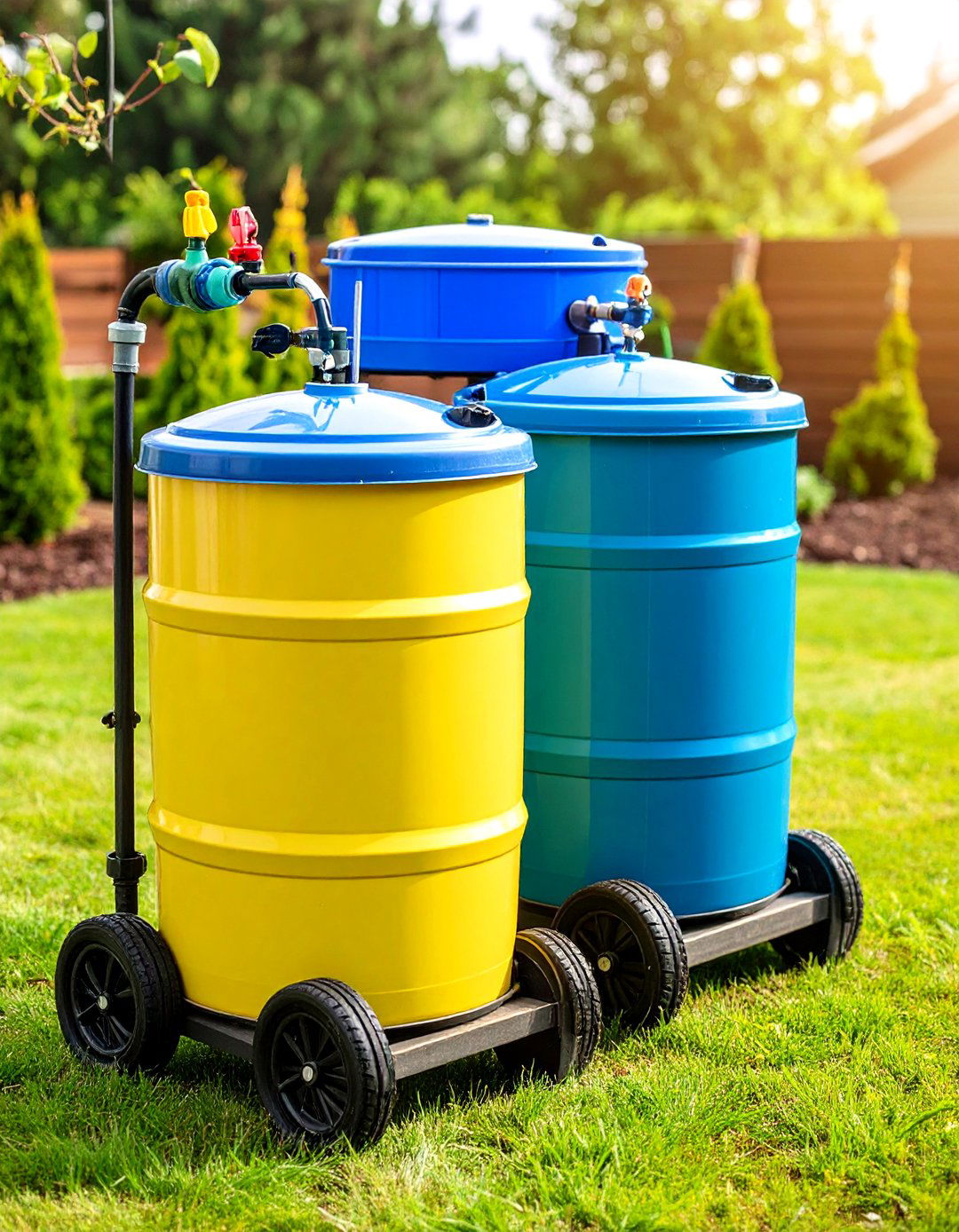
In Arizona it’s legal—and encouraged—to capture any rain that lands on your roof, so add a 50-gallon barrel under the downspout and start banking free water. A modest 1,000-square-foot roof collecting 10 inches of annual rain can net more than 6,000 gallons, enough to irrigate a full season of shrubs. Cistern suppliers note that stored rain flushes salts from desert soils and lowers your water bill in one swoop. Gravity-feed the barrel into your drip system or into passive basins dug around trees so every drop soaks in where roots can use it.
11. Arizona Backyard Outdoor Kitchen with Misters
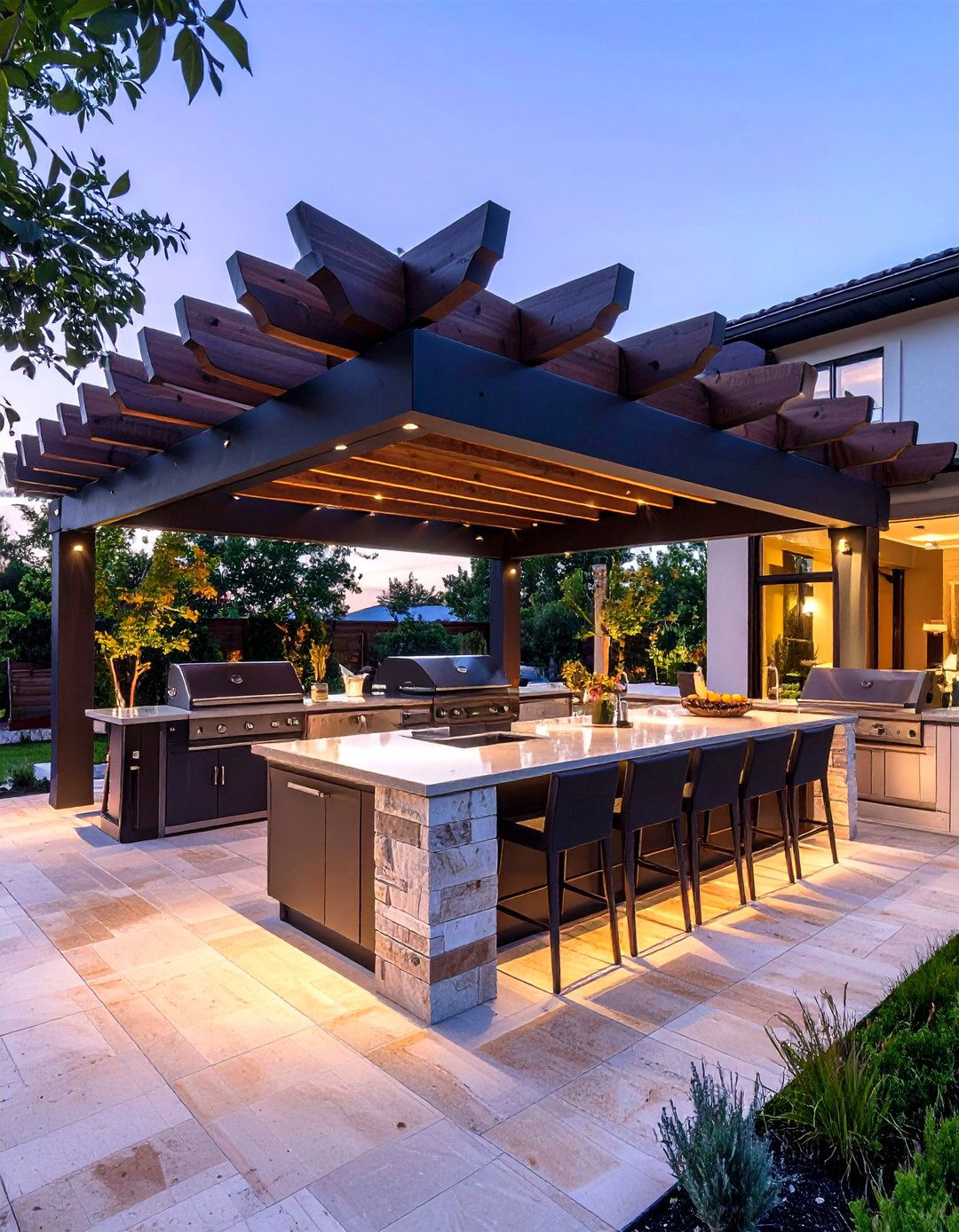
Architects now orient outdoor kitchens away from the harshest western sun, roofing them with heat-reflective pergolas and installing high-pressure misters that cool surfaces by 20 °F. Add a built-in grill, side burner, and mini fridge along a paver counter so weeknight dinners stay outdoors and indoor A/C units get a break. Use sealed, nonporous travertine or porcelain tiles that shrug off grease and hose clean in seconds. Finish with dimmable task lighting so you can sear steaks after sunset without attracting desert moths.
12. Arizona Backyard Pet Cooling Corner
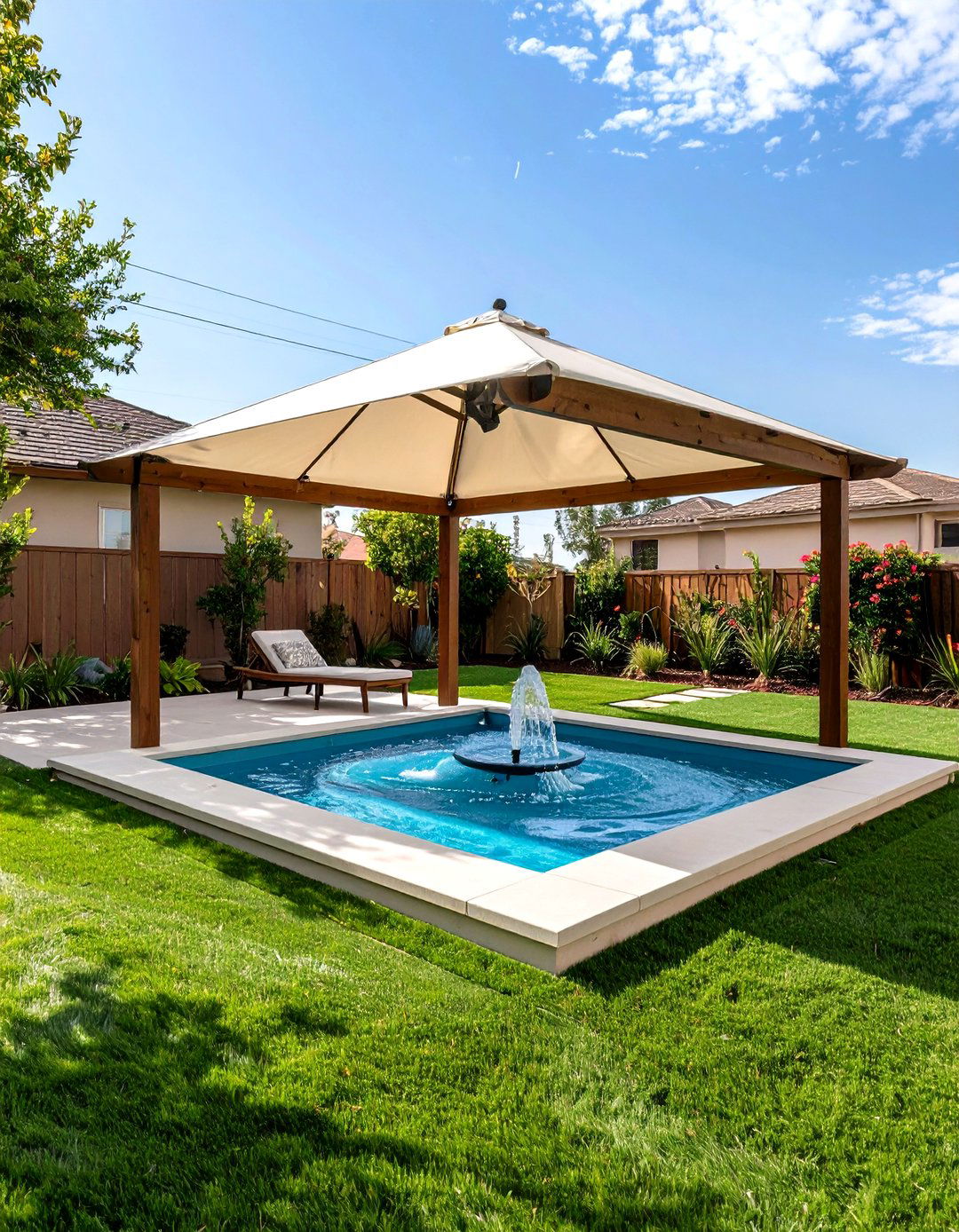
Dogs overheat fast on hot concrete, so give them a splash-pad retreat: a shallow dog-friendly pool rented or DIY-installed that stays shaded for zoomies. Add a paw-activated fountain so pups summon cool water on demand, a solution vets praise for hydration and fun. For walks, stash a cooling vest and keep asphalt paw checks part of the routine—if it burns your hand, it will burn their pads. Surround the corner with hardy shade cloth and artificial turf so puddles drain quickly and muddy paws stay out of the house.
13. Arizona Backyard Edible Desert Plant Bed

Mesquite trees drop sweet, protein-rich pods each June—grind them into flour or boil into syrup for a hyper-local superfood right outside your door. Interplant prickly-pear paddles for summer-long nopalitos and ruby fruits loaded with antioxidants. These native edibles evolved to thrive on scant rainfall and forgive missed watering cycles that doom traditional veggies. Add a pallet trellis for tepary beans, the Southwest’s most heat-tolerant legume, and you’ll harvest protein even when temperatures soar above 100 °F.
14. Arizona Backyard Calming Water Feature Nook
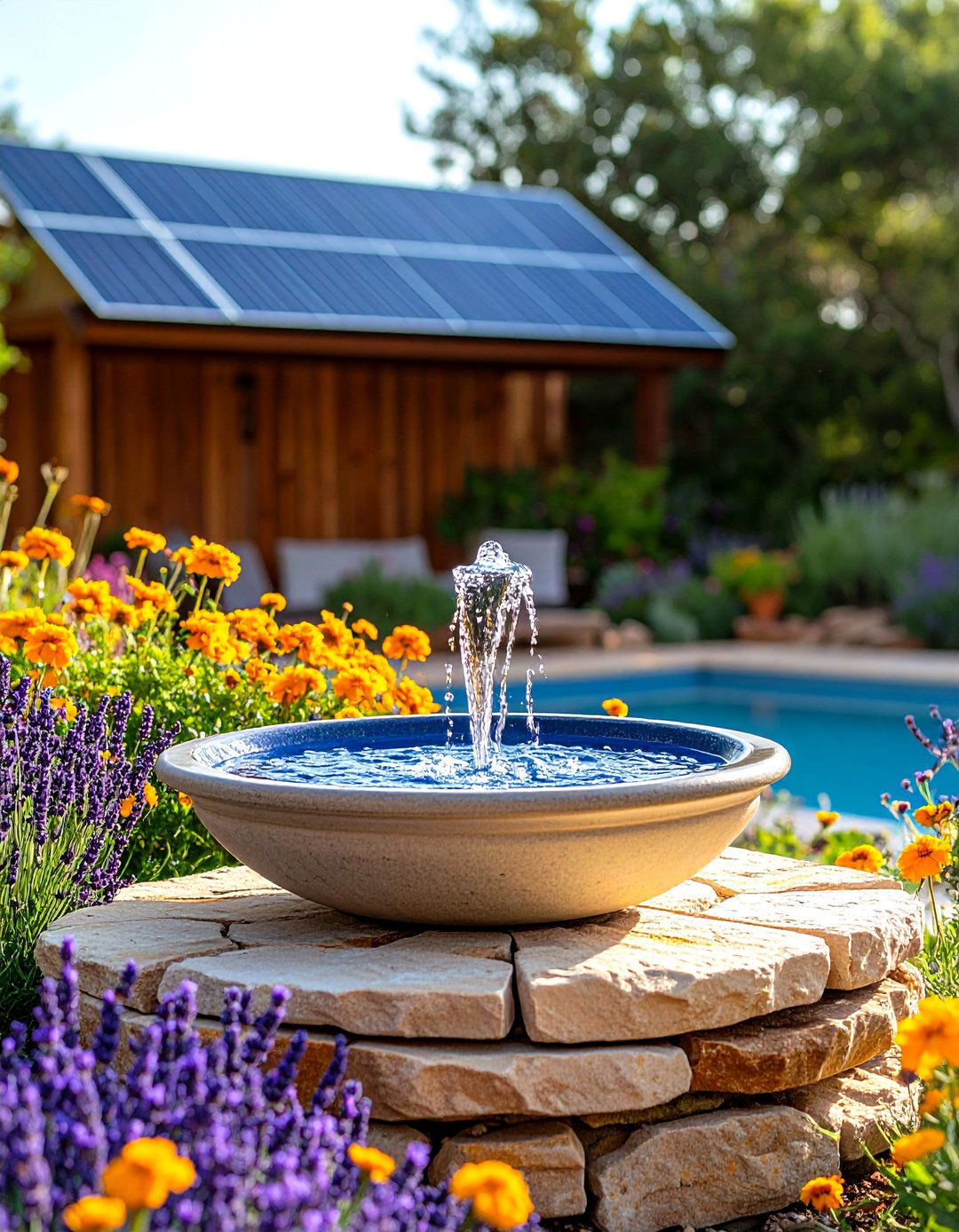
A tabletop bowl fountain recirculates less than two gallons yet adds the cooling sound of water and attracts songbirds searching for a safe sip. Nestle the bowl among desert marigold and lavender so droplets scent the air, then power the pump with a small 10-watt solar panel to avoid trenching for electricity. Elevate the basin on stacked flagstone to fascinate children and give quail a perch, creating a multisensory focal point at minimal cost and water use.
15. Arizona Backyard Decomposed Granite Pathways

Building a four-inch-deep decomposed-granite path creates a comfortable, nonslip surface that feels cooler than poured concrete under bare feet. DIYers love that stabilized DG compacts like asphalt yet drains summer monsoon downpours without puddling. Edging the trail with rust-colored steel keeps stones in place and visually ties the walkway to surrounding boulders. Add solar path lights every eight feet for safe night navigation while preserving dark-sky views.
16. Arizona Backyard Living Ocotillo Privacy Wall
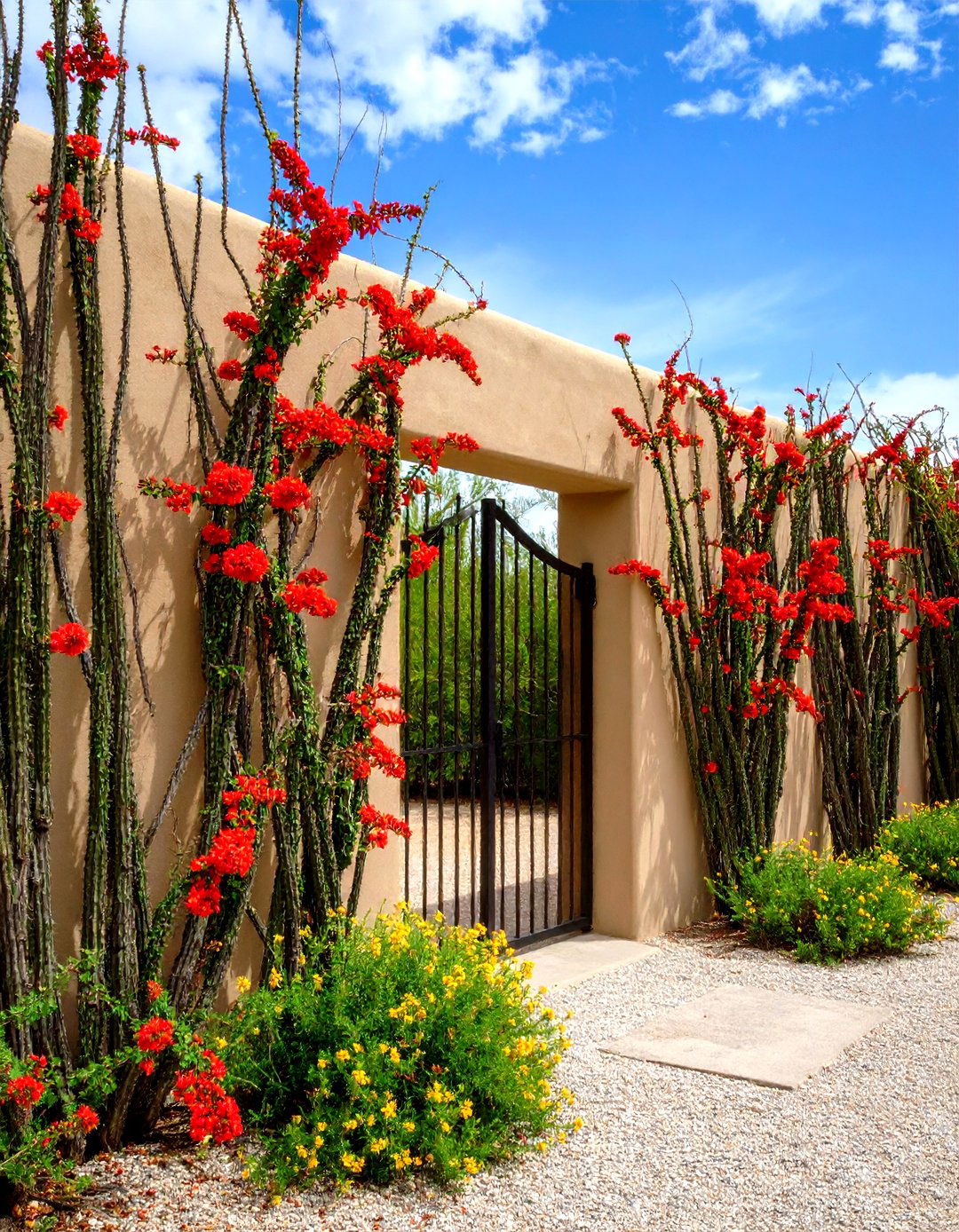
Ocotillo canes wired into panels and planted upright root along the base, sprouting green leaves after each rain to form a living, spiny privacy fence uniquely Southwestern. Modern gardeners appreciate that canes harvested legally will re-leaf seasonally, screening patios without blocking airflow or demanding extra irrigation. Over time, flowering tips blaze red in spring, drawing hummingbirds while discouraging trespassing pets. Install panels eight inches apart for airflow and tie in a matching ocotillo gate for style continuity.
17. Arizona Backyard Multi-Level Seating Terraces
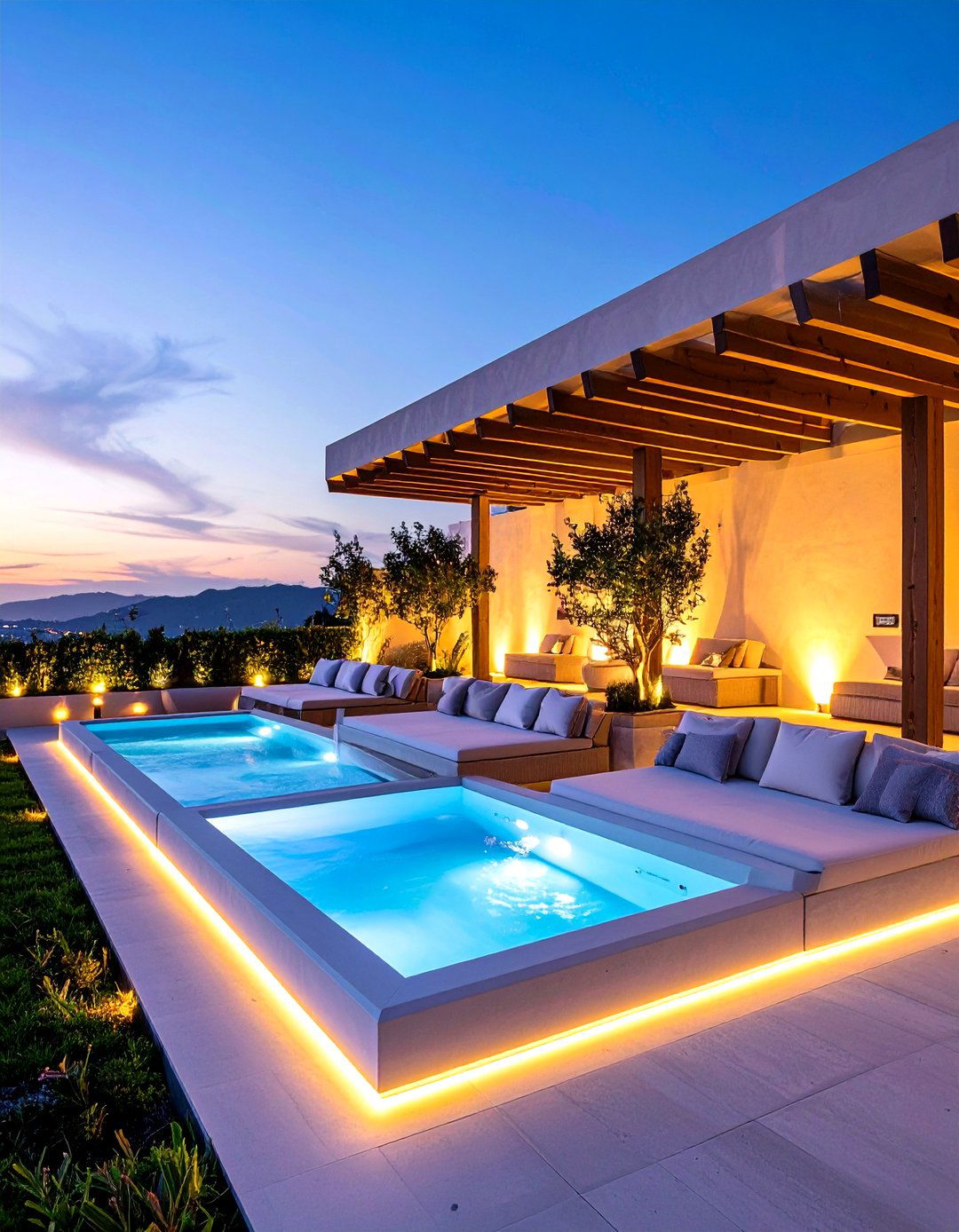
Sunken seating pits ringed by low retaining walls are dominating 2025 outdoor-living wish lists because they double as conversation nooks and wind breaks. Build terraces with interlocking concrete blocks or adobe-look veneer that complements surrounding pavers and gravel. Tuck LED strip lights under each capstone so steps glow at night, then integrate USB charging ports so guests can stream music without scattering extension cords. Plant fragrant desert ruellia behind the wall so evening breezes waft floral notes into the lounge.
18. Arizona Backyard Color-Rich Container Displays

Talavera and other glazed ceramic pots hold up under relentless sun as long as pigments are kiln-fired, adding bursts of cobalt, saffron, and turquoise without fading. Designers suggest clustering three differently sized pots beside sitting areas to mimic indoor side tables—a trick that feels fresh and costs little. Garden-décor experts say layering pots with string lights, patterned rugs, and solar lanterns delivers maximum impact for minimal budget. Use cactus-safe potting mix and add a tablespoon of pumice per quart so roots breathe even during monsoon humidity.
19. Arizona Backyard Solar-Powered Tech Upgrades
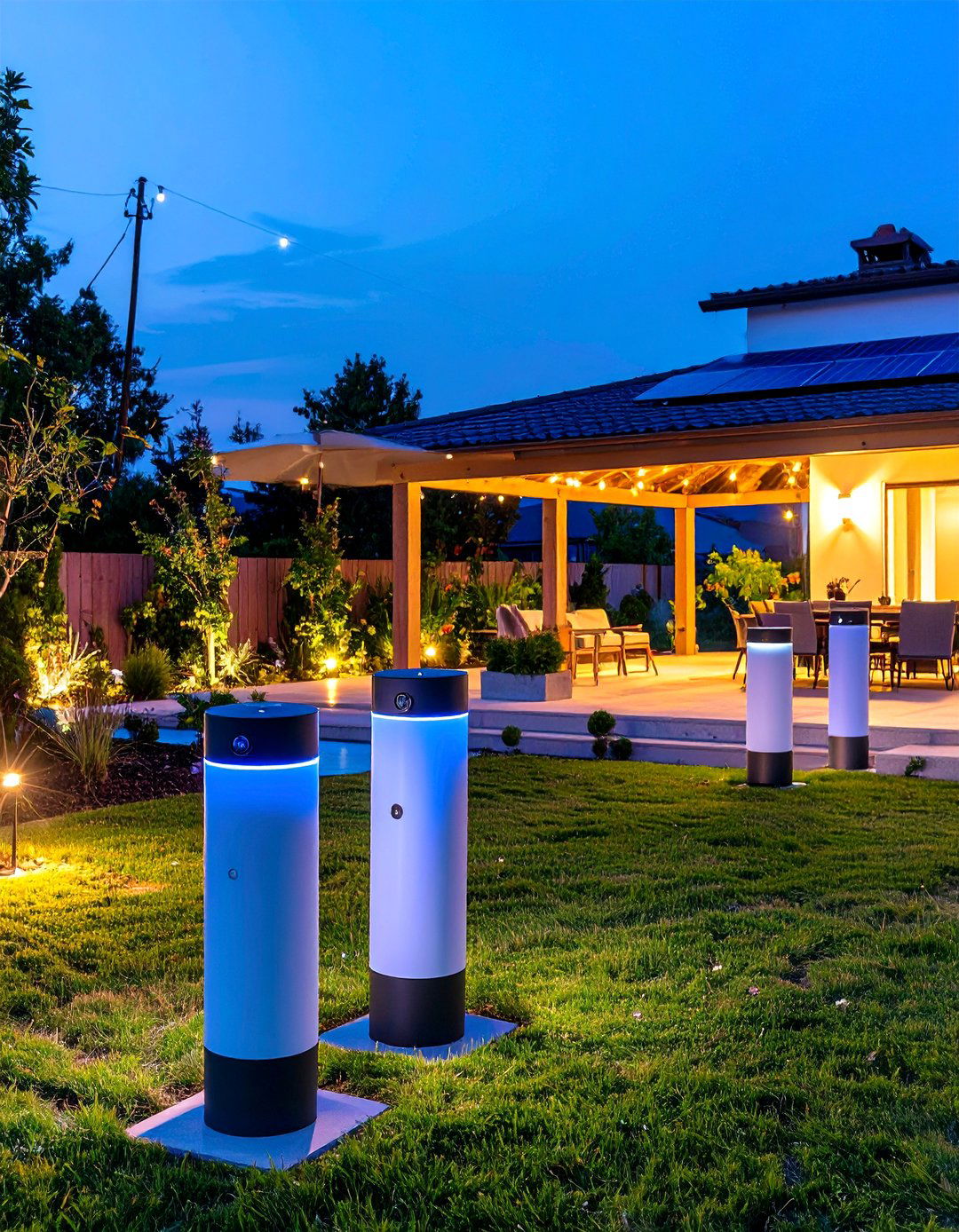
Low-voltage, solar-charged LEDs run all night on stored energy, eliminating trenching costs and slashing electric bills. Homeowners increasingly pair these fixtures with motion-sensing cameras and Wi-Fi mesh nodes hidden inside decorative bollards, extending internet outdoors for movie nights without extra wiring. Desert builders call this “night-scaping,” a trend that encourages post-sunset entertaining while honoring Dark-Sky principles through shielded beams. Add a photovoltaic trickle charger to power pond pumps or drip controllers, making your yard resilient during summer brownouts.
20. Arizona Backyard Wildlife-Friendly Micro-Habitat
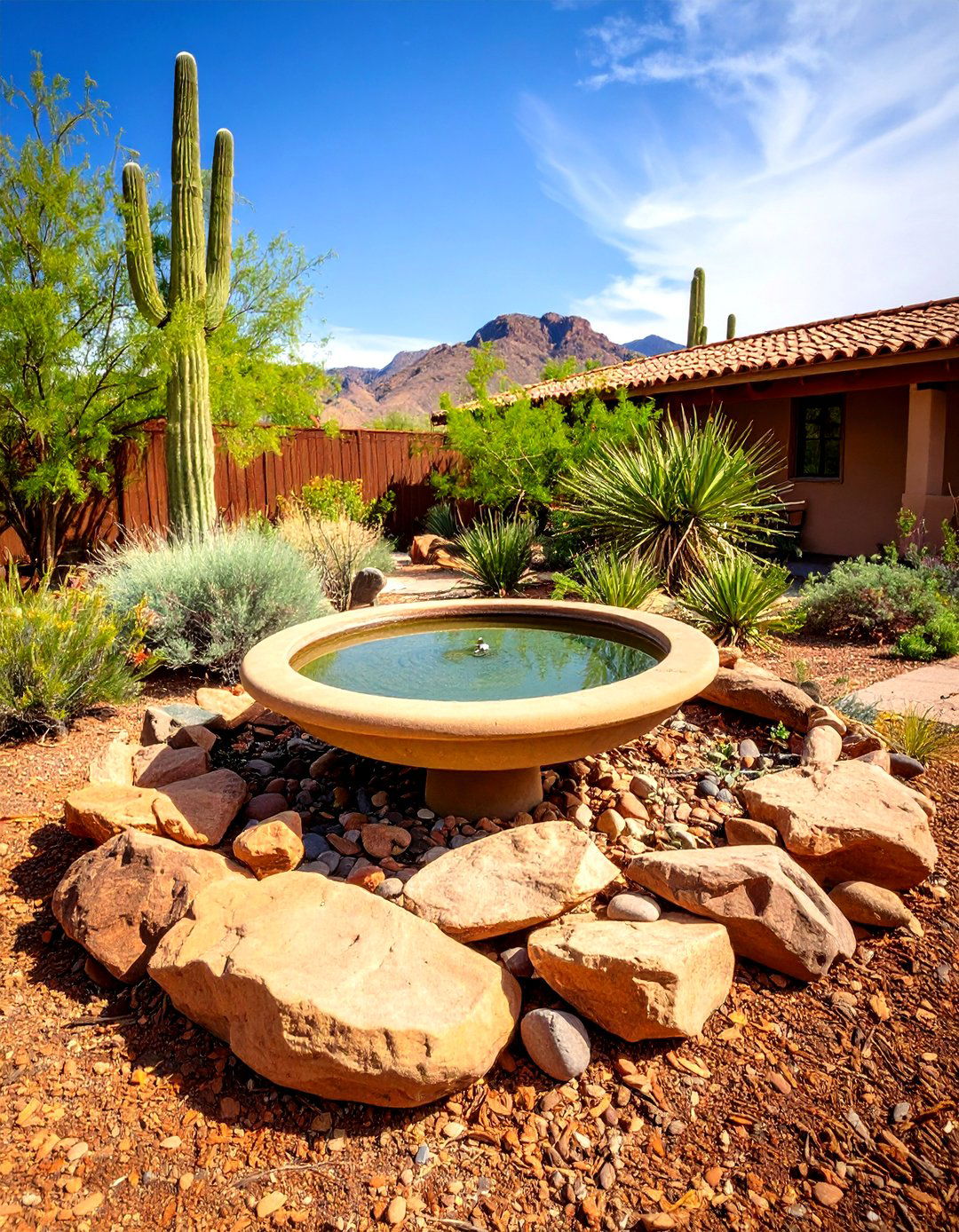
Provide a shallow, shaded birdbath, dense shrubs, and a few rock piles and you’ll attract quail, lizards, and butterflies within weeks. Water-wise advocates note that rain gardens and concave boulders double as drink stations for pollinators without wasting potable water. Leave leaf litter under cactus clusters; birds forage insects there, and lizards use the cover to escape predators. Skip pesticides so beneficial bugs thrive, then certify your yard with the National Wildlife Federation for a proud metal sign that sparks neighborly eco envy.
Conclusion:
Desert backyards thrive when design celebrates, rather than fights, the climate. From xeriscape beds and smart irrigation to mist-cooled kitchens and living ocotillo walls, these twenty Arizona backyard ideas prove you can create lush, livable spaces while respecting every drop of water and ray of sun. Use native plants, layered shade, solar tech, and thoughtful wildlife habitat to craft an outdoor haven that stays beautiful, functional, and sustainable—no matter how long the hot season lasts.


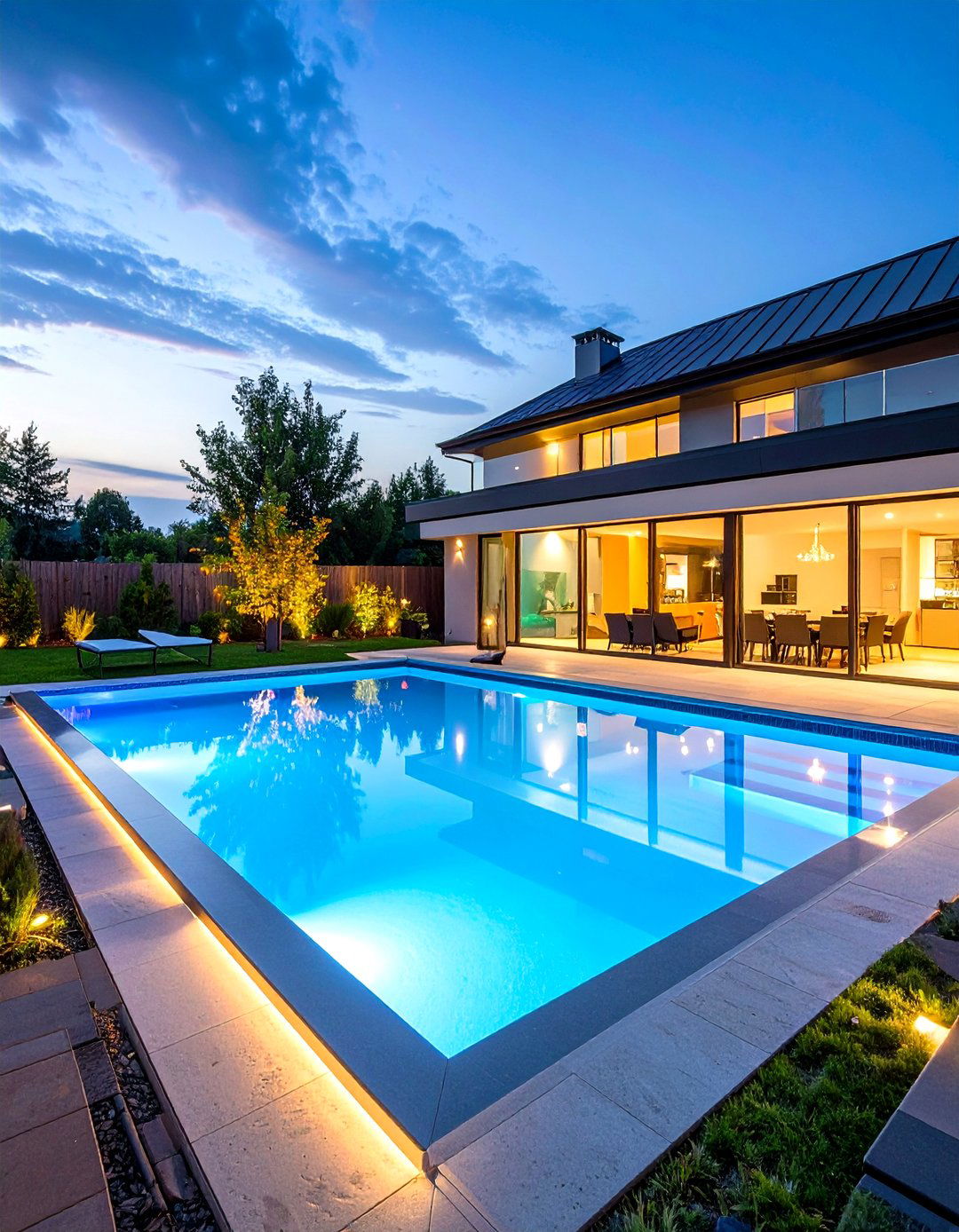
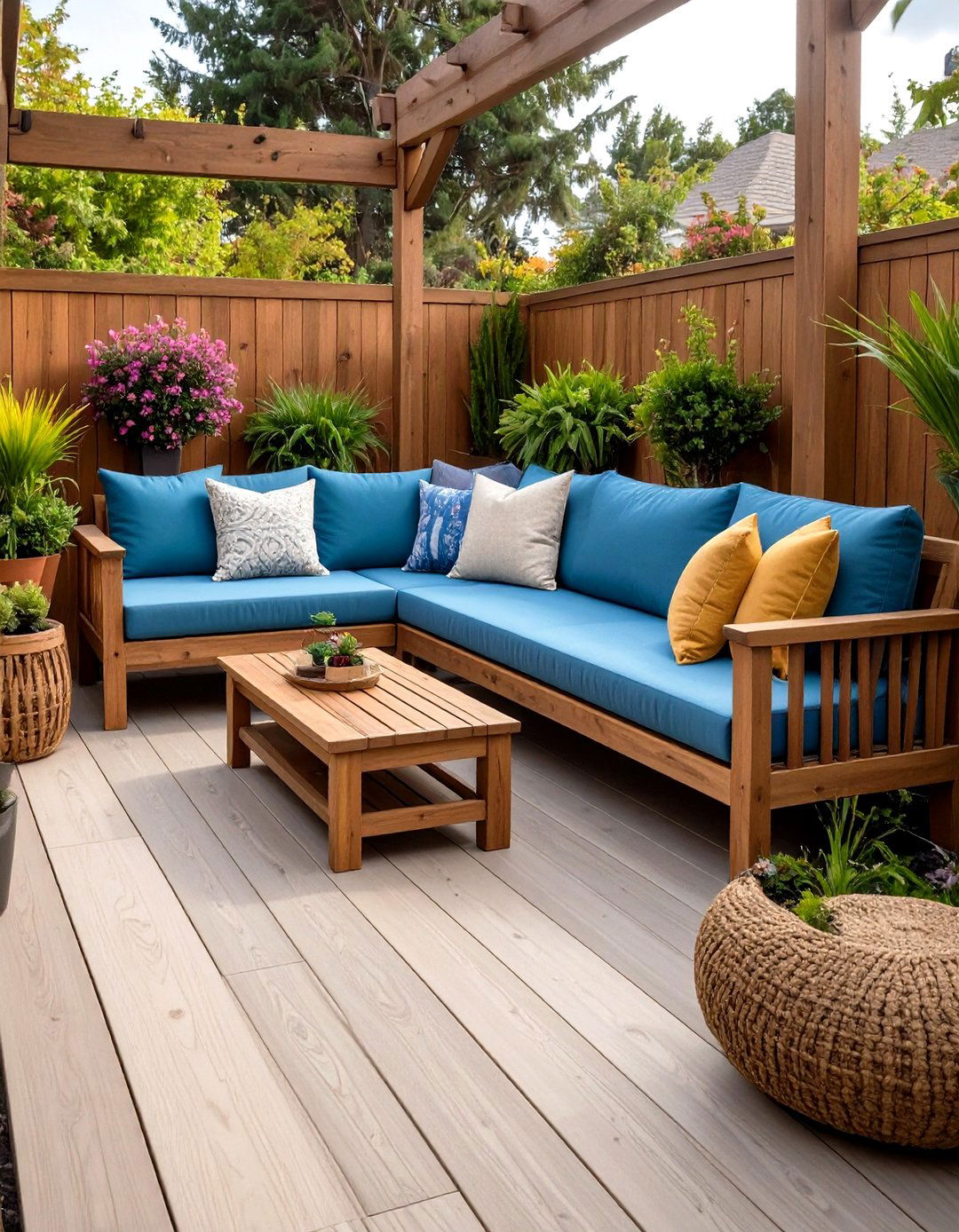
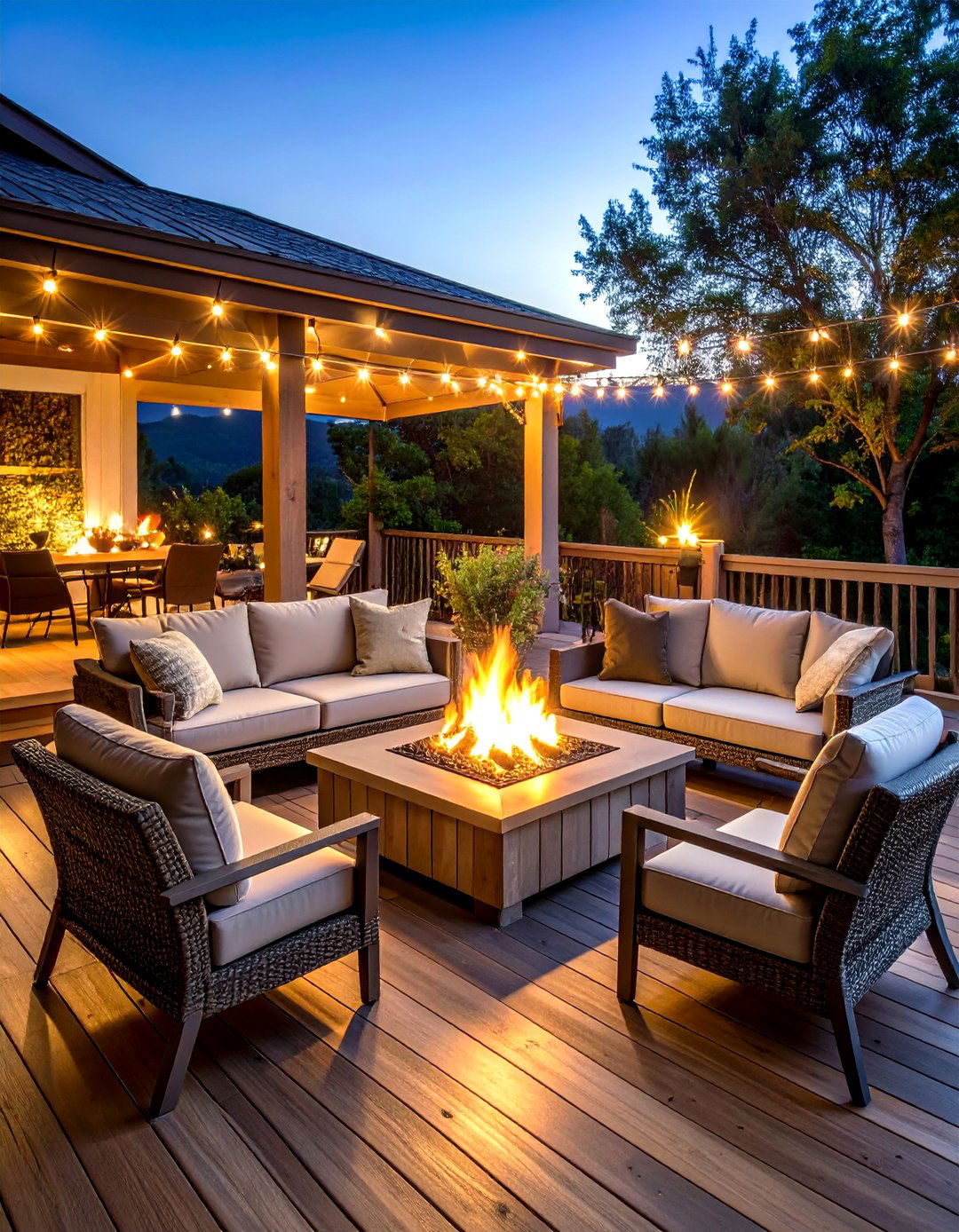
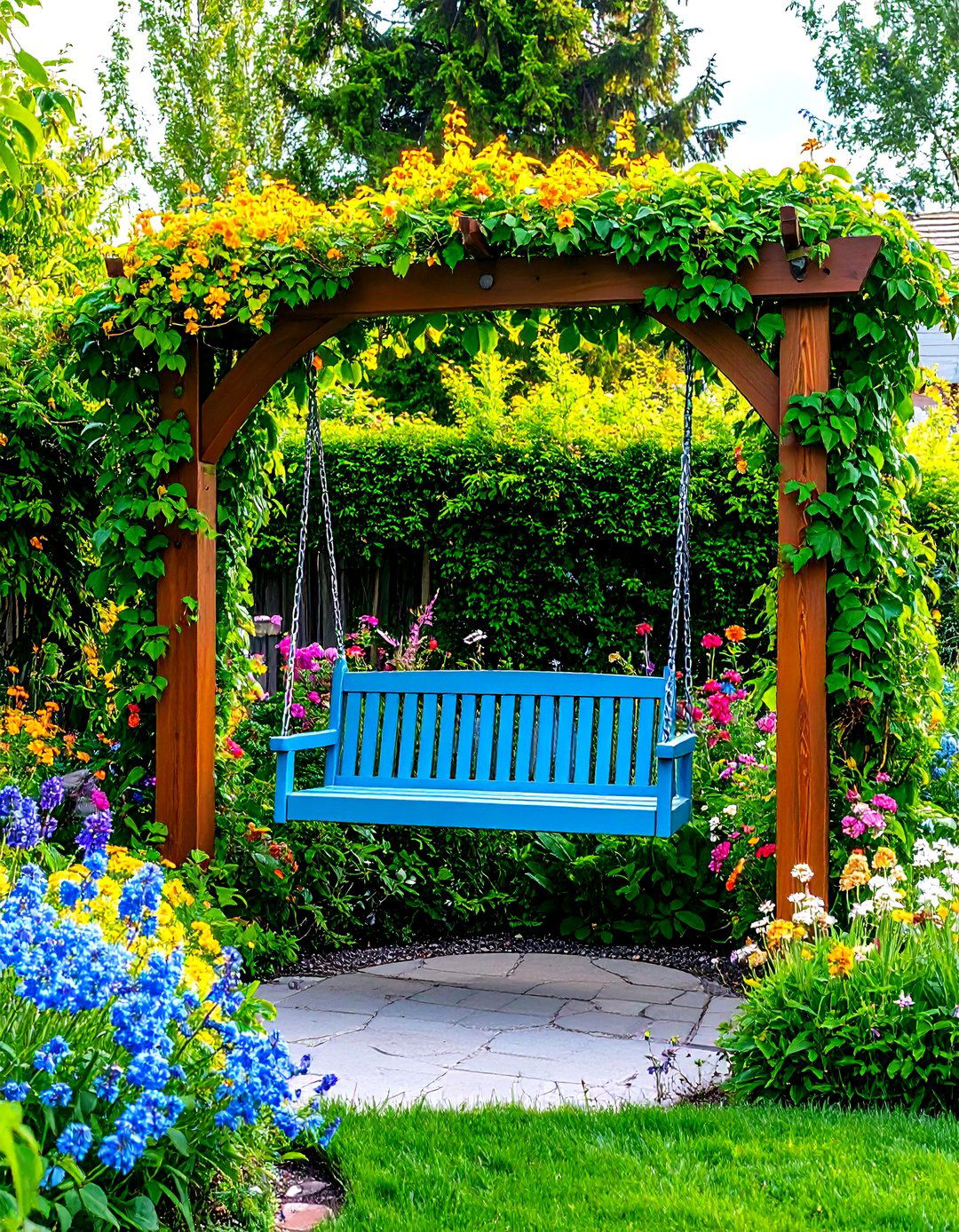
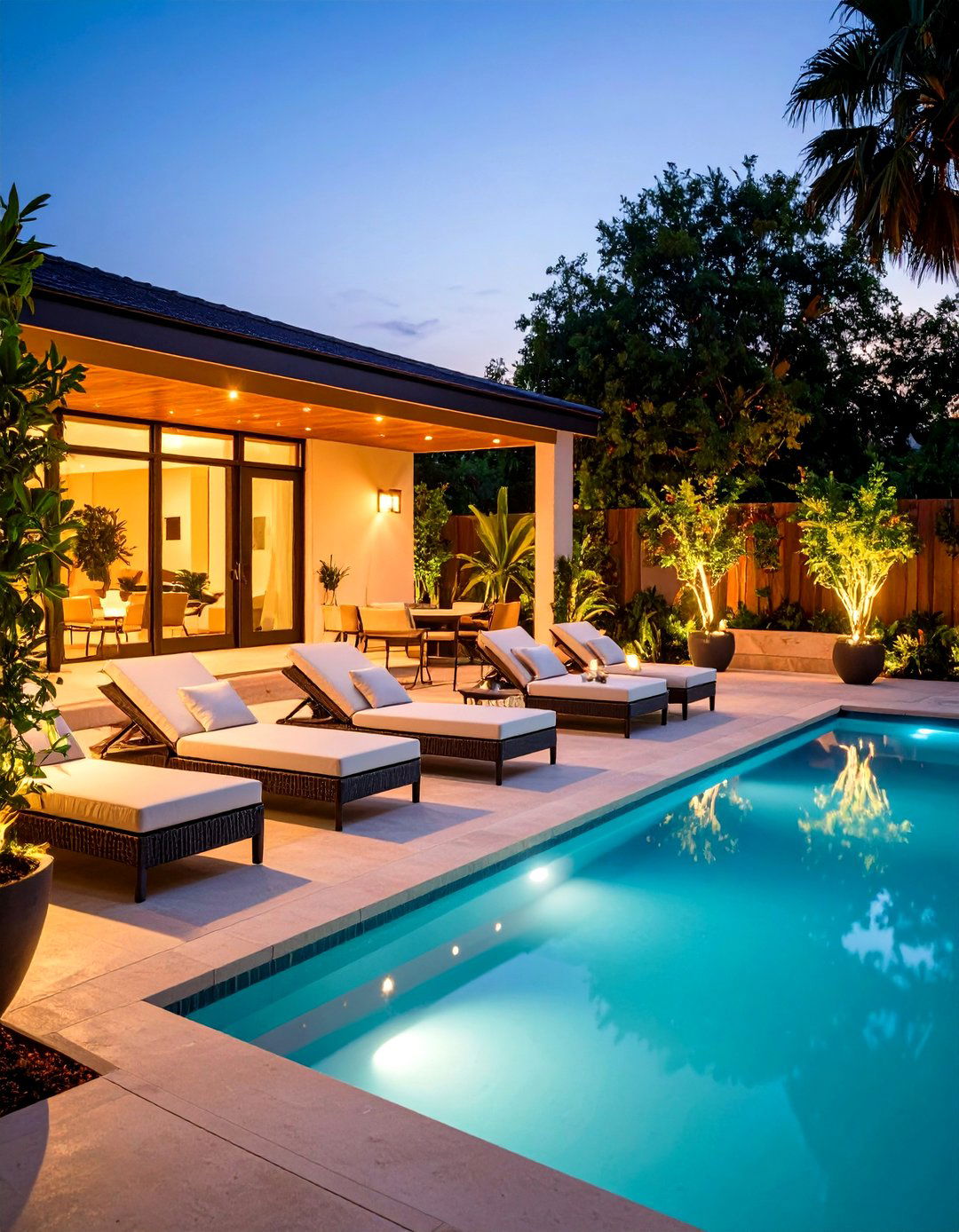
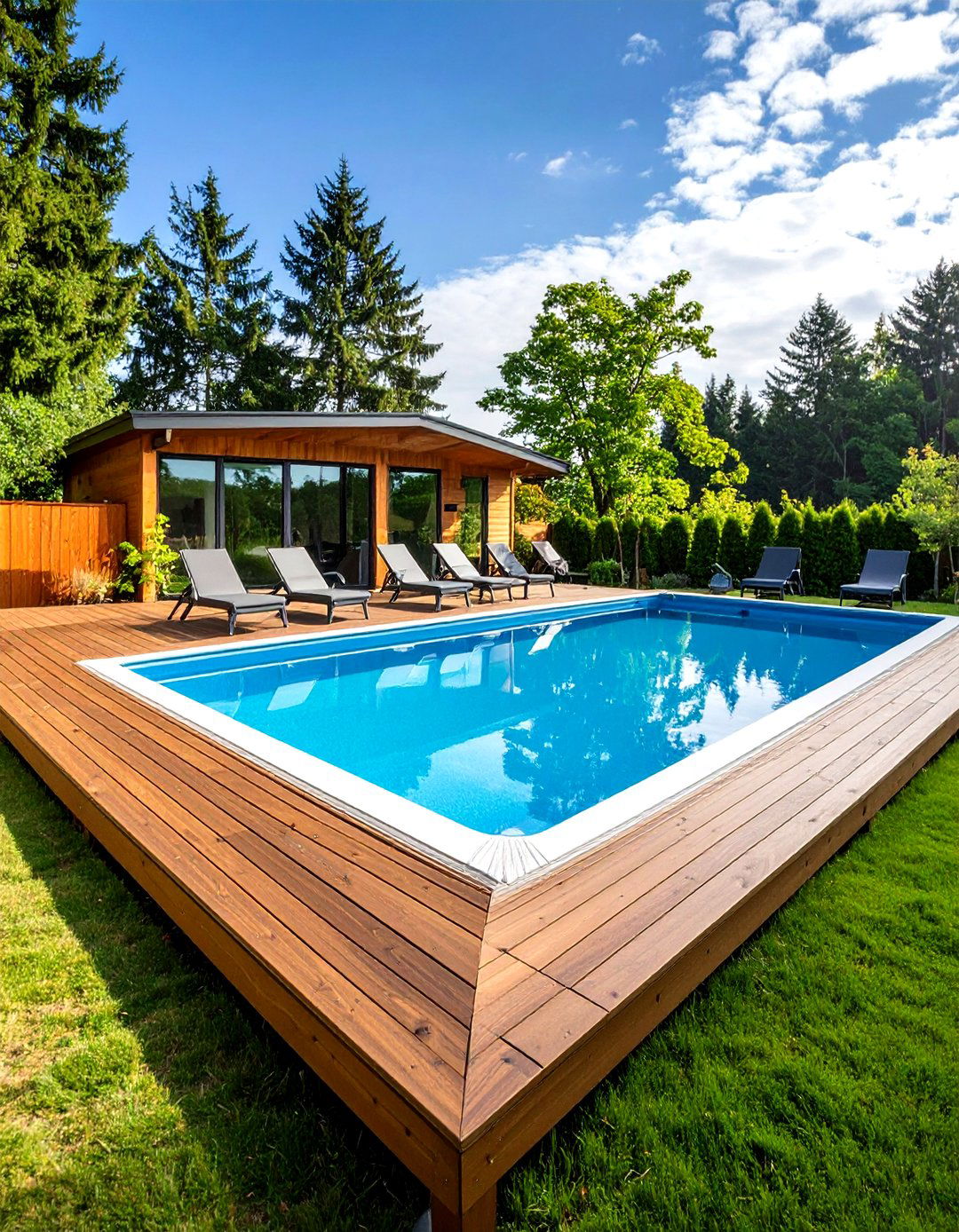
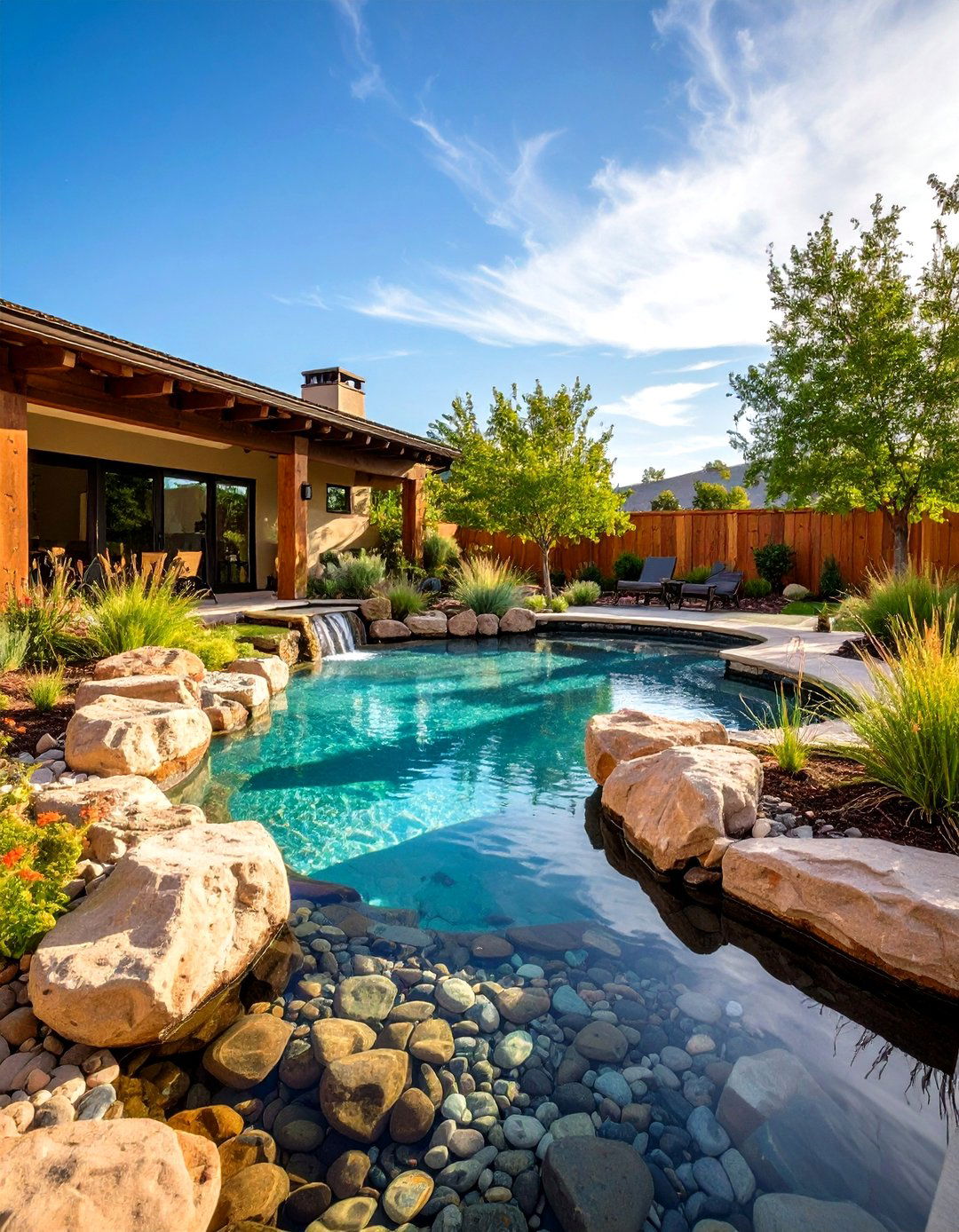
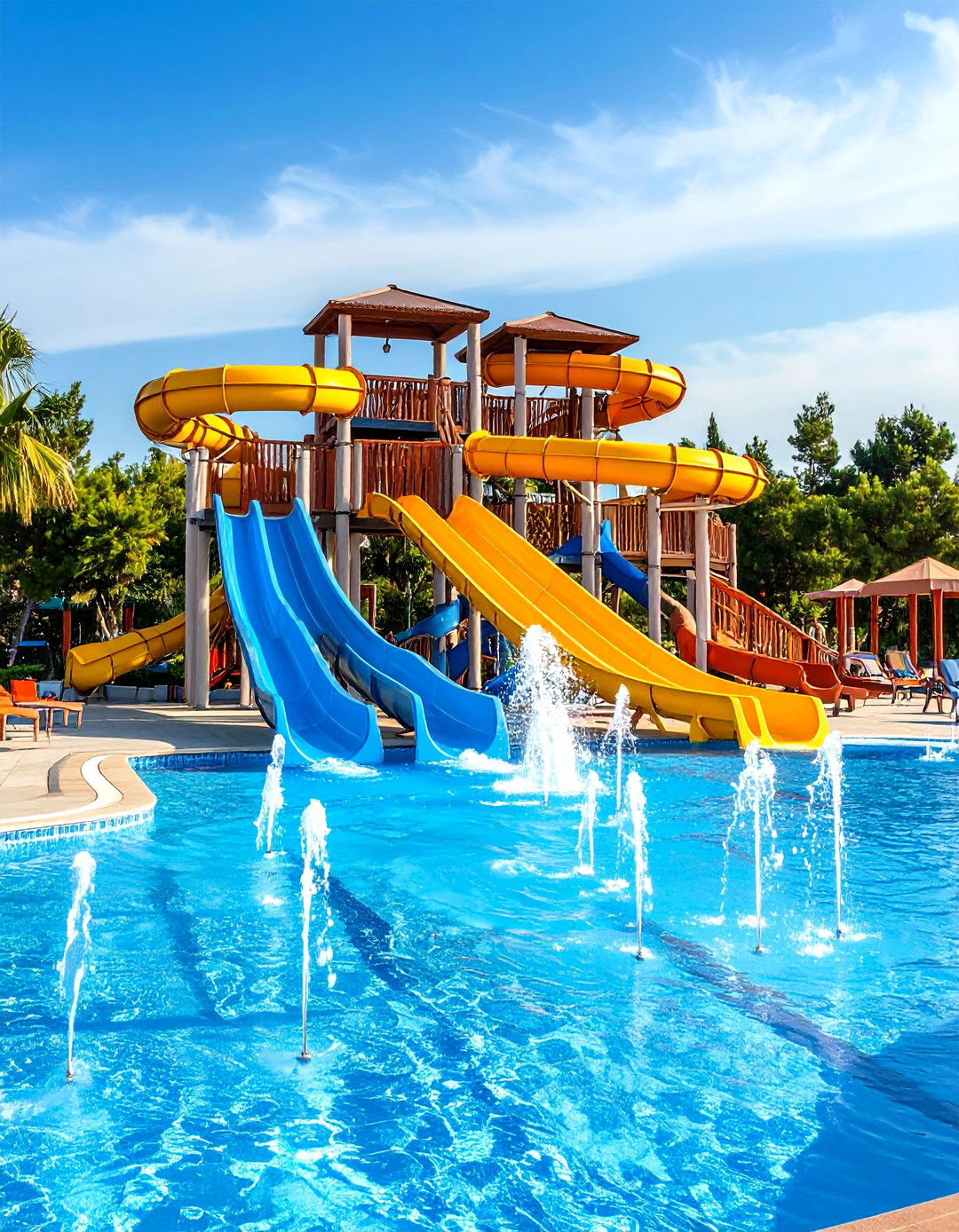

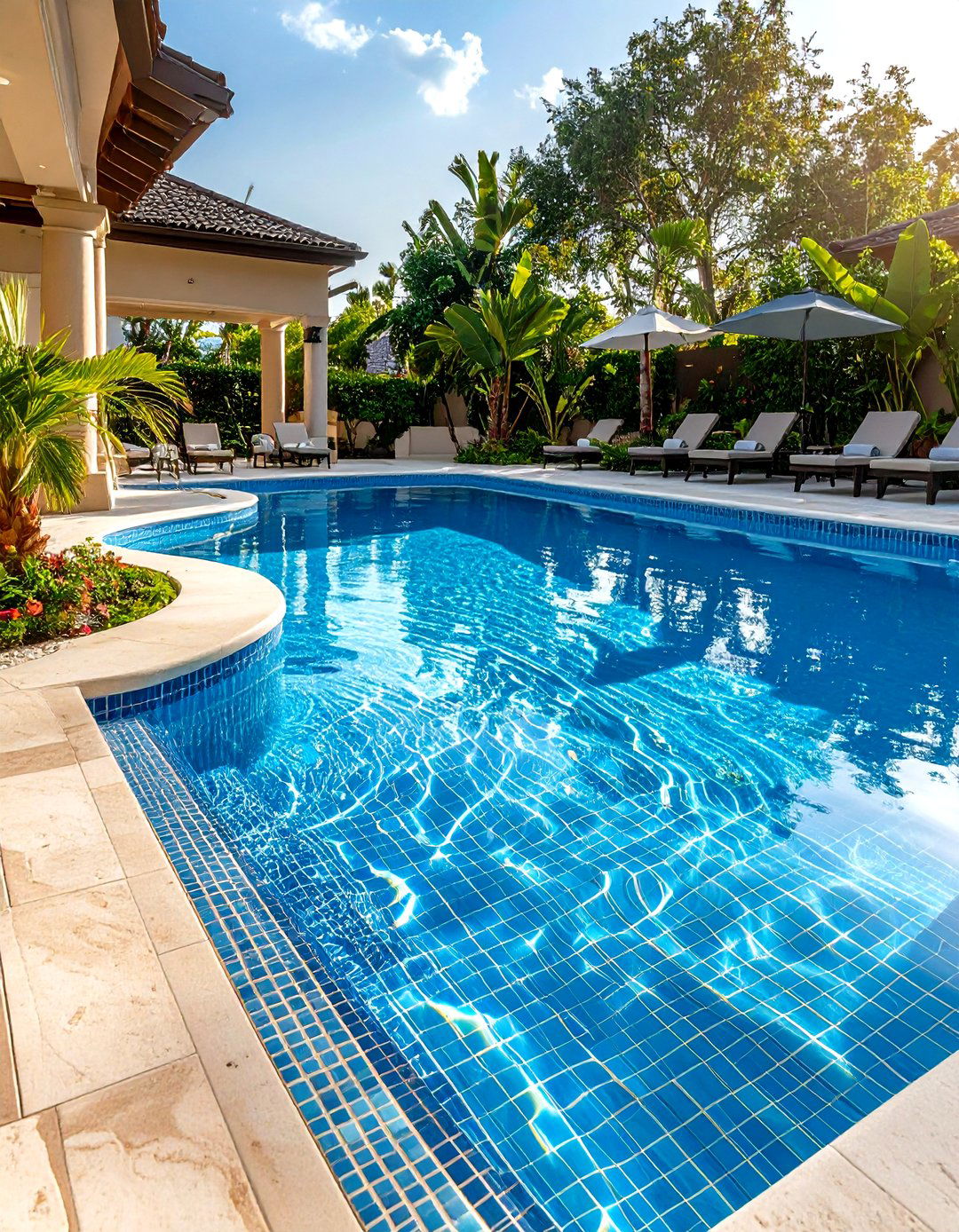

Leave a Reply